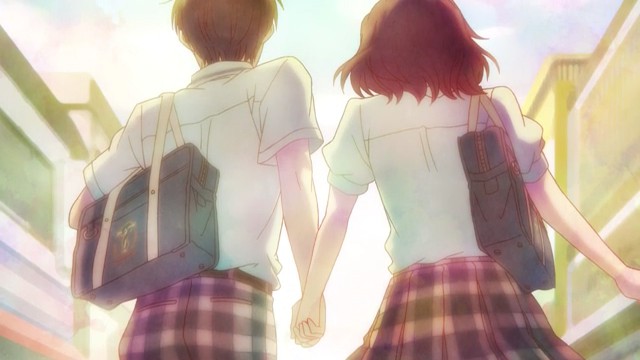 The ability of Kono Oto Tomare to get stuff done really is quite exceptional. I’ve noted it before but it bears repeating that this series manages to shoehorn as much character and plot development into a confined space as any anime out there. Even in a relative breather episode like this week’s several character arcs move forward at dizzying speed, which I suppose is reflective of the fact that it’s the shading between the lines that KoT is really focused on more that the conventional plot progression.
The ability of Kono Oto Tomare to get stuff done really is quite exceptional. I’ve noted it before but it bears repeating that this series manages to shoehorn as much character and plot development into a confined space as any anime out there. Even in a relative breather episode like this week’s several character arcs move forward at dizzying speed, which I suppose is reflective of the fact that it’s the shading between the lines that KoT is really focused on more that the conventional plot progression.
 First off we have Takinami-sensei, who stampedes right into the next phase of his role as club advisor without a trace of reserve. The key moment for Suzu-chan was admitting that he cared – for him, that’s the ultimate fear factor. Now that he’s effectively surrendered, he can do for the koto club what no one else currently can – try and help them understand what a real musician is and how they can go about becoming one. This he does with a modern composition prepared for the school festival, as well as bags of CDs and DVDs for the kids to listen to in order to try and gain some musical context. The fact that his parents are a famous conductor and a piano virtuoso is our clue that Takinami has only skimmed the surface of his musical background here.
First off we have Takinami-sensei, who stampedes right into the next phase of his role as club advisor without a trace of reserve. The key moment for Suzu-chan was admitting that he cared – for him, that’s the ultimate fear factor. Now that he’s effectively surrendered, he can do for the koto club what no one else currently can – try and help them understand what a real musician is and how they can go about becoming one. This he does with a modern composition prepared for the school festival, as well as bags of CDs and DVDs for the kids to listen to in order to try and gain some musical context. The fact that his parents are a famous conductor and a piano virtuoso is our clue that Takinami has only skimmed the surface of his musical background here.
 That last bit of information comes courtesy of Tetsu-kun, who gets roped in to tutoring the boys in the club after Suzu-chan warns them against punting their summer assignments and drawing the Kyouto-sensei’s unwanted attention again. Tetsu is one of the unsung heroes in this cast, a character who often lingers almost unnoticed on the fringes of the action – but his importance to Chika can hardly be overstated. Takezou (who’s been drafted as a teaching assistant) wonders why Tetsu has to decided to attend a relative also-ran of a school like Tokise given his obvious educational prowess, and received a non-committal answer, but one could easily draw their own conclusions about why Tetsu made that choice.
That last bit of information comes courtesy of Tetsu-kun, who gets roped in to tutoring the boys in the club after Suzu-chan warns them against punting their summer assignments and drawing the Kyouto-sensei’s unwanted attention again. Tetsu is one of the unsung heroes in this cast, a character who often lingers almost unnoticed on the fringes of the action – but his importance to Chika can hardly be overstated. Takezou (who’s been drafted as a teaching assistant) wonders why Tetsu has to decided to attend a relative also-ran of a school like Tokise given his obvious educational prowess, and received a non-committal answer, but one could easily draw their own conclusions about why Tetsu made that choice.
 Meanwhile, Suzu-chan has caused one more earthquake for the club during his breezy intervention earlier, appointing Sane-kun as the group’s new 17-string player. Sane is another one of those on-the-periphery characters, but his role in the baka trio is pretty clear and it matches the one in the ensemble – he’s stable, reliable and direct. No drama, no headlines – but one can easily see that he recognizes and appreciates the compliment Takinami-sensei’s decision is to him. And it’s strategically crucial too, because it frees up the group’s superstar to express her own virtuosity without having to carry the burden of being the rhythmic anchor.
Meanwhile, Suzu-chan has caused one more earthquake for the club during his breezy intervention earlier, appointing Sane-kun as the group’s new 17-string player. Sane is another one of those on-the-periphery characters, but his role in the baka trio is pretty clear and it matches the one in the ensemble – he’s stable, reliable and direct. No drama, no headlines – but one can easily see that he recognizes and appreciates the compliment Takinami-sensei’s decision is to him. And it’s strategically crucial too, because it frees up the group’s superstar to express her own virtuosity without having to carry the burden of being the rhythmic anchor.
 Let’s be honest, though – in the end, the biggest waves this episode makes come from the bows of its proudly-sailing ships. There’s a lot of staging work going on here, putting the pieces in place for later advancement up the board, and the message it sends is not an especially subtle one. Takezou and Hiro are together on the shopping committee for their class’ festival activity (a waffle stand), and Satowa and Chika work together on their class’ Japanese-style cafe. These two pairings certainly make an interesting contrast, and at times like this one is reminded that there’s a year’s difference in age between them. That often seems unimportant in Kono Oto Tomare but there are times when it really shows in their behavior, and this is one of them.
Let’s be honest, though – in the end, the biggest waves this episode makes come from the bows of its proudly-sailing ships. There’s a lot of staging work going on here, putting the pieces in place for later advancement up the board, and the message it sends is not an especially subtle one. Takezou and Hiro are together on the shopping committee for their class’ festival activity (a waffle stand), and Satowa and Chika work together on their class’ Japanese-style cafe. These two pairings certainly make an interesting contrast, and at times like this one is reminded that there’s a year’s difference in age between them. That often seems unimportant in Kono Oto Tomare but there are times when it really shows in their behavior, and this is one of them.
 Much of the tension between the junior couple comes down to unintended physical contact and the hilariously unhinged reactions it elicits from them – these two are already pretty much at the “get a room” stage. But things are subtler and more complicated with Hiro and Takezou, each of them much painfully aware of the baggage they’re carrying on-board ship even if neither is acknowledging they’re at sail in the first place. The scene where the errand-running pair run into “that” couple in the shoutengai is one of those lightning-bolt transitions that Kono Oto Tomare specializes in – an unnerving moment that feels incredibly dangerous after an episode of mostly fluffy affirmation.
Much of the tension between the junior couple comes down to unintended physical contact and the hilariously unhinged reactions it elicits from them – these two are already pretty much at the “get a room” stage. But things are subtler and more complicated with Hiro and Takezou, each of them much painfully aware of the baggage they’re carrying on-board ship even if neither is acknowledging they’re at sail in the first place. The scene where the errand-running pair run into “that” couple in the shoutengai is one of those lightning-bolt transitions that Kono Oto Tomare specializes in – an unnerving moment that feels incredibly dangerous after an episode of mostly fluffy affirmation.
 If it’s emotional development you’re after, KoT delivers as much bang for your buck as any series out there. This shounen is as rich in relationship drama as any shoujo, with a cast full of characters who all seem to get their moment to shine. It – like Chihayafuru – is a good reminder that it’s easy to get too caught up in demographic distinctions when in the end, they really only matter when it comes to which section the manga gets shelved in at the bookstore.
If it’s emotional development you’re after, KoT delivers as much bang for your buck as any series out there. This shounen is as rich in relationship drama as any shoujo, with a cast full of characters who all seem to get their moment to shine. It – like Chihayafuru – is a good reminder that it’s easy to get too caught up in demographic distinctions when in the end, they really only matter when it comes to which section the manga gets shelved in at the bookstore.
OP: “Rainbow” by Yuuma Uchida






































leongsh
October 14, 2019 at 11:58 amTetsu is not only Chika’s best friend, he is also effectively Chika’s guardian angel. He doesn’t want to see Chika go down the trail of self-destruction like he did earlier in middle school. He wants to make sure that Chika stays in the light of living and active engagement instead of the darkness of despair.
Takezou has come out of his shell to be more confident. That line thrown back at the guy was devastating. If lines could kill, that line would have left a dead body there.